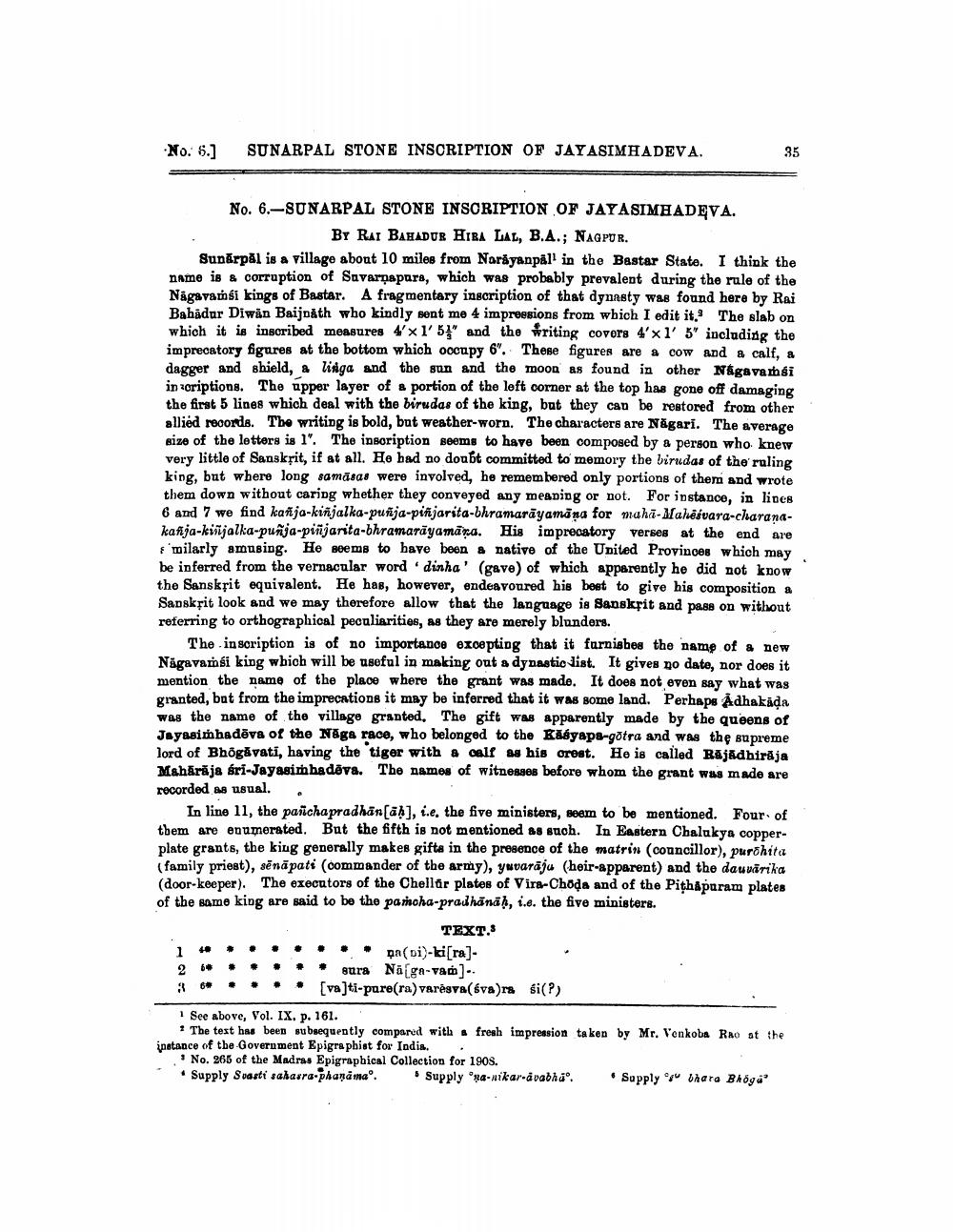________________
No. 6.]
SUNARPAL STONE INSCRIPTION OF JAYASIMHADEVA.
No. 6.-SUNARPAL STONE INSCRIPTION OF JAYASIMHADEVA.
BY RAI BAHADUR HIRA LAL, B.A.; NAGPUR.
Sunarpal is a village about 10 miles from Narayanpal' in the Bastar State. I think the name is a corruption of Suvarnapura, which was probably prevalent during the rule of the Nagavaṁsi kings of Bastar. A fragmentary inscription of that dynasty was found here by Rai Bahadur Diwan Baijnath who kindly sent me 4 impressions from which I edit it. The slab on which it is inscribed measures 4'x1' 5" and the writing covers 4' x 1' 5" including the imprecatory figures at the bottom which occupy 6". These figures are a cow and a calf, a dagger and shield, a linga and the sun and the moon as found in other Nágavaméi inscriptions. The upper layer of a portion of the left corner at the top has gone off damaging the first 5 lines which deal with the birudas of the king, but they can be restored from other allied records. The writing is bold, but weather-worn. The characters are Nagari. The average size of the letters is 1". The inscription seems to have been composed by a person who knew very little of Sanskrit, if at all. He had no doubt committed to memory the birudas of the ruling king, but where long samāsas were involved, he remembered only portions of them and wrote them down without caring whether they conveyed any meaning or not. For instance, in lines 6 and 7 we find kañja-kiñjalka-puñja-piñjarita-bhramarayamana for maha-Mahesvara-charanakafija-kinjalka-punja-piñjarita-bhramarayamaza. His imprecatory verses at the end are
milarly amusing. He seems to have been a native of the United Provinces which may be inferred from the vernacular word dinha' (gave) of which apparently he did not know the Sanskrit equivalent. He has, however, endeavoured his best to give his composition a Sanskrit look and we may therefore allow that the language is Sanskrit and pass on without referring to orthographical peculiarities, as they are merely blunders.
The inscription is of no importance excepting that it furnishes the name of a new Nägavamsi king which will be useful in making out a dynastic list. It gives no date, nor does it mention the name of the place where the grant was made. It does not even say what was granted, but from the imprecations it may be inferred that it was some land. Perhaps Adhakaḍa was the name of the village granted. The gift was apparently made by the queens of Jayasimhadeva of the Naga race, who belonged to the Kasyapa-gotra and was the supreme lord of Bhōgavati, having the tiger with a calf as his crest. He is called Rajadhirāja Mahārāja śri-Jayasimhadeva. The names of witnesses before whom the grant was made are recorded as usual.
40
1 2 64 R 6*
In line 11, the pañchapradhan[äḥ], i.e. the five ministers, seem to be mentioned. Four of them are enumerated. But the fifth is not mentioned as such. In Eastern Chalukya copperplate grants, the king generally makes gifts in the presence of the matrin (councillor), purohita (family priest), senapati (commander of the army), yuvaraju (heir-apparent) and the dauvarika (door-keeper). The executors of the Chellar plates of Vira-Choda and of the Pithapuram plates of the same king are said to be the pancha-pradhānāḥ, i.e. the five ministers.
TEXT.3
*
35
pa (bi)-ki[ra]
sura Naga-vam]..
[va]ti-pare(ra) varēsva(sva)ra si(?)
1 See above, Vol. IX. p. 161.
The text has been subsequently compared with a fresh impression taken by Mr. Venkoba Rao at the instance of the Government Epigraphist for India.
No. 265 of the Madras Epigraphical Collection for 1908. Supply Svasti sahasra-phanama".
5 Supply na-nikar-āvabhä°.
Supply bhara Bhöga




